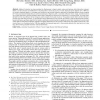Free Online Productivity Tools
i2Speak
i2Symbol
i2OCR
iTex2Img
iWeb2Print
iWeb2Shot
i2Type
iPdf2Split
iPdf2Merge
i2Bopomofo
i2Arabic
i2Style
i2Image
i2PDF
iLatex2Rtf
Sci2ools
VIS
2009
IEEE
2009
IEEE
Volume Illustration of Muscle from Diffusion Tensor Images
Medical illustration has demonstrated its effectiveness to depict salient anatomical features while hiding the irrelevant details. Current solutions are ineffective for visualizing fibrous structures such as muscle, because typical datasets (CT or MRI) do not contain directional details. In this paper, we introduce a new muscle illustration approach that leverages diffusion tensor imaging (DTI) data and example-based texture synthesis techniques. Beginning with a volumetric diffusion tensor image, we reformulate it into a scalar field and an auxiliary guidance vector field to represent the structure and orientation of a muscle bundle. A muscle mask derived from the input diffusion tensor image is used to classify the muscle structure. The guidance vector field is further refined to remove noise and clarify structure. To simulate the internal appearance of the muscle, we propose a new two-dimensional examplebased solid texture synthesis algorithm that builds a solid texture constrained ...
Guidance Vector Field | Muscle Illustration Approach | Muscle Structure | VIS 2009 | Visualization |
| Added | 06 Nov 2009 |
| Updated | 08 Dec 2009 |
| Type | Conference |
| Year | 2009 |
| Where | VIS |
| Authors | Wei Chen, Zhicheng Yan, Song Zhang, John Allen Crow, David S. Ebert, Ronald M. McLaughlin, Katie B. Mullins, Robert Cooper, Ziang Ding, Jun Liao |
Comments (0)

